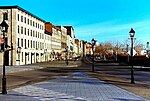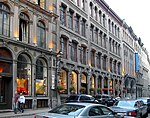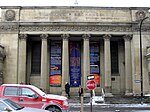Fort Ville-Marie

Fort Ville-Marie was a French fortress and settlement established in May 1642 by a company of French settlers, led by Paul de Chomedey de Maisonneuve, on the Island of Montreal in the Saint Lawrence River at the confluence of the Ottawa River, in what is today the province of Quebec, Canada. Its name is French for "City of Mary", a reference to the Blessed Virgin Mary. It is the historic nucleus around which the original settlement of Montreal grew. The settlement became a centre for the fur trade and French expansion into North America until the Treaty of Paris in 1763, which ended the French and Indian War and ceded the territory of New France to Britain. Given its importance, the site of the fort was designated a National Historic Site of Canada in 1924.
Excerpt from the Wikipedia article Fort Ville-Marie (License: CC BY-SA 3.0, Authors, Images).Fort Ville-Marie
Place Royale, Montreal Ville-Marie
Geographical coordinates (GPS) Address Nearby Places Show on map
Geographical coordinates (GPS)
| Latitude | Longitude |
|---|---|
| N 45.503407 ° | E -73.553974 ° |
Address
Place Royale 351
H2Y 1Z5 Montreal, Ville-Marie
Quebec, Canada
Open on Google Maps










